Man, let me tell you, this whole Virgo physical trait research thing started because of the most ridiculous argument I’ve had in years. It wasn’t planned. I didn’t wake up one day thinking, “I need to scientifically categorize people based on their birth month.” Nah. I was deep in the trenches of a bathroom renovation gone wrong.
My contractor had vanished, the tile was three weeks late, and the stress was making me chew my fingernails down to the bone. My neighbor, who is a self-proclaimed, hyper-organized, textbook Virgo—the kind of guy who alphabetizes his spices—decided to pop over right in the middle of this mess. He wasn’t there to help, of course. He was there to brag about his perfect symmetry.
“Look at my jawline,” he declared, adjusting his perfectly ironed shirt. “Sharp. Symmetrical. It’s the Virgo precision. We’re aesthetically superior.”
I just stared at him, covered in drywall dust. I called BS. But the guy wouldn’t drop it. He insisted that if you line up a hundred Virgos, you’d see the pattern: neat hairlines, defined noses, maybe even a specific average height. I told him that was utter crap, but he planted the seed. I was too stressed to deal with the tile, so I needed a new, complicated, pointless distraction. Proving this schmuck wrong became my new mission.
The Data Collection Chaos
I decided I had to gather evidence. Real, messy, observational data. But how do you get physical measurements from strangers without sounding like a total lunatic? I started small.
First, I harassed every friend and relative I knew who was born between August 23rd and September 22nd. I told them I was doing an art project. I asked for clear, forward-facing photos, and then I asked for weird stuff:
-
Actual head circumference: Yes, I made them use tape measures.
-
Nose tip to lip distance: This one got the most confused texts.
-
Hairline definition: Sharp V-shape? Rounded? Receding?
The immediate problem? The sample size was tiny, and most of my friends have terrible measuring skills. The measurements were all over the map. I realized I needed volume.
So, I dove into the weird world of social media groups. I filtered dating apps by birth date. I started joining astrology forums, pretending to be a super enthusiastic amateur researcher. My criteria were rough, maybe even insulting, but I needed to categorize what I saw:
I set up categories like: Angular Face (Y/N), Small Eyes (Y/N), High Forehead (Y/N). Honestly, half the time I was just guessing based on low-resolution photos.
I pulled about 400 profiles over two weeks. It was exhausting, tedious, and borderline creepy. I kept thinking about how much more productive it would be to just finish the damn bathroom tiling, but I was invested now. The neighbor had won the first battle, I needed to win the war.
Sifting Through the Mess
I dumped all this observational crap into a spreadsheet. I organized it, which felt ironic considering the subject matter. My neighbor would have approved of the spreadsheet structure, but not the contents.
I crunched the numbers, looking for any pattern—any statistical blip that suggested Virgos were consistently taller, had narrower faces, or shared some ancient Greek ideal of proportion.
Here’s what I found, and it’s the expert analysis promised in the title:
-
Height: Completely random. I had Virgos who were 5’1” and Virgos who were 6’7”.
-
Facial Symmetry: Nothing specific. Some had sharp jawlines, others had soft, rounded faces. The only commonality was maybe a slightly higher than average number of people who wore glasses, but that’s probably confirmation bias because my data set skewed towards educated office workers.
-
The “Neat” Look: This was the only psychological component that actually showed up. A lot of the male Virgos in the dating app pool had impeccably groomed beards and very neat haircuts. The females often favored classic, polished styles. But that’s a behavioral trait, not a physical one.
The conclusion was stone-cold simple: Physically, a Virgo looks like a person. That’s it. The celestial body alignment has zero measurable impact on your nose bridge.
The Unexpected Aftermath
So, I went back to my neighbor, tiled bathroom finally functional, and presented my findings. He dismissed the entire thing, claiming my methodology was flawed because I didn’t have enough “pure” samples—whatever that means.
But here’s the kicker. That two weeks of intense, obsessive, pattern-recognition work wasn’t a total waste. While I was scraping data, I got really fast at recognizing specific photo biases and user profile patterns. I started noticing things about how people presented themselves online that went beyond just astrology.
A few months later, still needing extra cash because that contractor totally stiffed me, I saw a strange job posting for an image categorization gig—basically identifying visual trends in massive data sets. I applied for the hell of it, mentioning my weird “personal project” involving facial metrics and arbitrary criteria. They loved the honesty and the strange, specific pattern-recognition skills I’d accidentally developed while trying to prove my neighbor was full of it.
I got the job. It’s totally remote, pays way better than tiling, and it only exists because I decided to spend two weeks trying to figure out if Virgos all have the same damn nose. So, while I proved that astrology doesn’t dictate bone structure, the pointless research dictated my new career path. Go figure.





